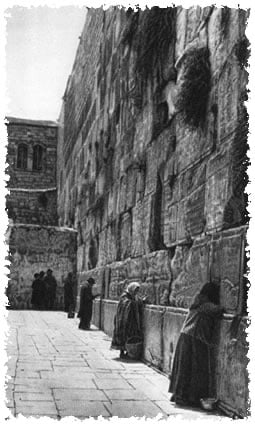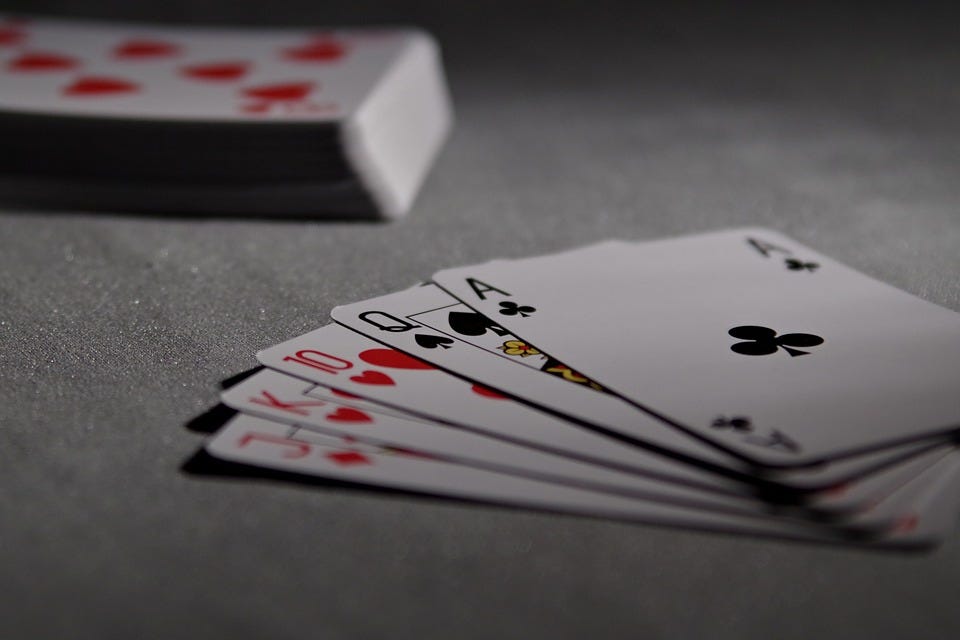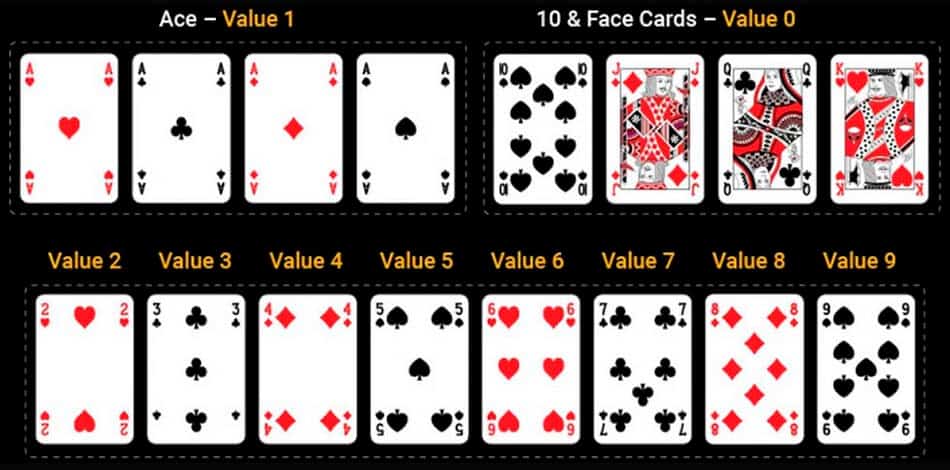How To Count Cards In Baccarat
- Appendices
- Baccarat Analysis
- Miscellaneous
We tested the Baccarat Card Counting System against a live dealer. Grab the spreadsheet here: https://www.dropbox.com/s/gb698po686jlina/Baccarat%20Counting.x.
How to Count Cards to Win Baccarat. The description in the above title is incomplete. It should be: How to count cards to exploit third card asymmetrical play to win baccarat in banker bets and tie bets as a standee. You already know that you can count cards to win in tie games. Card counting in Baccarat means that the higher or more positive the count is, the more likely it is for the player side to win. If you have a total count of (+5), keep your bet on the player side. Although the banker side winning generally issues a small commission for the casino but playing the tie side is never a good idea since the odds are.
Introduction
In either blackjack or baccarat a good first step in developing a card counting strategy is to determine the effect of removing any given card from the game. The following table shows the number of banker, player, and tie wins resulting from the removing of one card in an 8-deck shoe. The card removed is indicated in the image--leftolumn.
Number
| Card Removed | Banker Win | Player Win | Tie Win |
|---|---|---|---|
| 1 | 2259266202814720 | 2198201626637560 | 468838163231312 |
| 2 | 2259390347439480 | 2198279181695870 | 468636463548240 |
| 3 | 2259415336955130 | 2198240411263230 | 468650244465232 |
| 4 | 2259565639560830 | 2198132965463160 | 468607387659600 |
| 5 | 2259056540713470 | 2198626760121850 | 468622691848272 |
| 6 | 2259230629854970 | 2198942636434940 | 468132726393680 |
| 7 | 2259288625471740 | 2198847351781120 | 468170015430736 |
| 8 | 2258880877214840 | 2198299582316670 | 469125533152080 |
| 9 | 2259013211112320 | 2198292198535290 | 469000583035984 |
| 10 | 2259094649086970 | 2198163195365880 | 469048148230736 |
The next table puts these number is some perspective by indicating the probability of a banker, player, and tie win according to the card removed.
Probability
| Card Removed | Banker Win | Player Win | Tie Win |
|---|---|---|---|
| 1 | 0.458613 | 0.446217 | 0.09517 |
| 2 | 0.458638 | 0.446233 | 0.095129 |
| 3 | 0.458643 | 0.446225 | 0.095132 |
| 4 | 0.458673 | 0.446203 | 0.095123 |
| 5 | 0.45857 | 0.446303 | 0.095127 |
| 6 | 0.458605 | 0.446367 | 0.095027 |
| 7 | 0.458617 | 0.446348 | 0.095035 |
| 8 | 0.458534 | 0.446237 | 0.095229 |
| 9 | 0.458561 | 0.446235 | 0.095203 |
| 10 | 0.458578 | 0.446209 | 0.095213 |
The next table shows the house edge of each bet by card removed.
House Edge
| Card Removed | Banker | Player | Tie |
|---|---|---|---|
| 1 | 0.010535 | 0.012396 | 0.143467 |
| 2 | 0.010527 | 0.012405 | 0.143836 |
| 3 | 0.010514 | 0.012418 | 0.14381 |
| 4 | 0.010463 | 0.01247 | 0.143889 |
| 5 | 0.010662 | 0.012267 | 0.143861 |
| 6 | 0.010692 | 0.012238 | 0.144756 |
| 7 | 0.010662 | 0.012269 | 0.144688 |
| 8 | 0.010629 | 0.012298 | 0.142942 |
| 9 | 0.010602 | 0.012326 | 0.14317 |
| 10 | 0.01056 | 0.012369 | 0.143083 |
The next table shows the effect on the house edge of each bet according to the card removed. A negative number indicates removal is bad for the player, positive indicates removal is good.
House Edge
| Card Removed | Banker | Player | Tie |
|---|---|---|---|
| 0 | 0.000019 | -0.000018 | 0.000513 |
| 1 | 0.000044 | -0.000045 | 0.000129 |
| 2 | 0.000052 | -0.000054 | -0.000239 |
| 3 | 0.000065 | -0.000067 | -0.000214 |
| 4 | 0.000116 | -0.000120 | -0.000292 |
| 5 | -0.000083 | 0.000084 | -0.000264 |
| 6 | -0.000113 | 0.000113 | -0.001160 |
| 7 | -0.000083 | 0.000082 | -0.001091 |
| 8 | -0.00005 | 0.000053 | 0.000654 |
| 9 | -0.000023 | 0.000025 | 0.000426 |
The next table multiplies the above numbers by ten million.
Count Adjustment
| Card Removed | Banker | Player | Tie |
|---|---|---|---|
| 0 | 188 | -178 | 5129 |
| 1 | 440 | -448 | 1293 |
| 2 | 522 | -543 | -2392 |
| 3 | 649 | -672 | -2141 |
| 4 | 1157 | -1195 | -2924 |
| 5 | -827 | 841 | -2644 |
| 6 | -1132 | 1128 | -11595 |
| 7 | -827 | 817 | -10914 |
| 8 | -502 | 533 | 6543 |
| 9 | -231 | 249 | 4260 |
| Average | 0 | 0 | 0 |
To adapt this information to a card counting strategy, the player should start with three running counts of zero. As each card is seen as it leaves the shoe the player should add the point values of that card to each running count. For example if the first card to be played is an 8 then the three running counts would be: banker=-502, player=533, tie=6543. Of course the player does not have to keep a running track of all three counts. In fact the point values for the banker and player are nearly opposite of each other. A high running count for the banker would mean a corresponding low count for the player, and vise versa.
In order for any given bet to become advantageous the player should divide the running count by the ratio of cards left in the deck to get the true count. A bet hits zero house edge at the following true counts:
- Banker: 105791
- Player: 123508
- Tie: 1435963
Assuming you were able to actually play this strategy perfectly you would notice that the true counts seldom passed the point of zero house edge. The next table shows the ratio of hands played, based on a sample of 100 million, in which the true count passes the break even points above. The image--leftolumn indicates the ratio of cards dealt before the cards are shuffled.
Positive Expectation
| Penetration | Banker | Player | Tie |
|---|---|---|---|
| 90 percent | 0.000131 | 0.000024 | 0.000002 |
| 95 percent | 0.001062 | 0.000381 | 0.000092 |
| 98 percent | 0.005876 | 0.003700 | 0.002106 |

The final table indicates the expected revenue per 100 bets and a $1000 wager every time a positive expected value occured. Please remember that this table assumes the player is able to keep a perfect count and the casino is not going to mind the player only making a bet once every 475 hands of less.
Expected Profit
| Penetration | Banker | Player | Tie |
|---|---|---|---|
| 90 percent | $0.01 | $0.00 | $0.00 |
| 95 percent | $0.20 | $0.06 | $0.15 |
| 98 percent | $2.94 | $1.77 | $11.93 |
I hope this section shows that for all practical purposes baccarat is not a countable game. For more information on a similar experiment I would recomment The Theory of Blackjack by Peter A. Griffin. Although the book is mainly devoted to blackjack he has part of a chapter titled 'Can Baccarat Be Beaten?' on pages 216 to 223. Griffin concludes by saying that even in Atlantic City, with a more liberal shuffle point than Las Vegas, the player betting $1000 in positive expectation hands can expect to profit 70 cents an hour.
For your further consideration I would recommend this baccarat odds calculator. You can put in any deck composition and it will give the house edge on all three bets.
Go back to baccarat
Go to baccarat appendix 1
Go to baccarat appendix 3
Go to baccarat appendix 4
Go to baccarat appendix 5
Go to baccarat appendix 6
Go to baccarat appendix 7
Written by: Michael Shackleford
| No votes (0%) | |
| 2 votes (18.18%) | |
| 1 vote (9.09%) | |
| No votes (0%) | |
| No votes (0%) | |
| No votes (0%) | |
| 2 votes (18.18%) | |
| No votes (0%) | |
| 5 votes (45.45%) | |
| 6 votes (54.54%) |
11 members have voted
WizardAdministrator
However, one topic I've had on my list of ideas is card counting in baccarat. It can be used to cut down the house edge, but very very rarely will it overcome it. That said, please visit my new page on Card Counting in Baccarat. It shows how to easily cut down the house edge of 0.93%.
I'm sure someone will say to just play blackjack, which I agree with. However, this at least addresses the topic in more depth than I've ever seen done before.
I welcome all comments on my article.
The question for the poll is what is your baccarat strategy?
I count cards in Baccarat using Eliot Jacobson’s system (10,9 = 0, 1,2,3 =-1, 4 =-2, 5,7,8=1 and 6=2). I bet on Banker until the true count hits about +2 or so, then I'll switch to Player. If the true count is in the range of -2 to +3, I'll usually bet only half my normal wager. If the count gets anywhere from about -6 to +6, which usually happens near the end of the shoe, I’ll double my normal wager.
As you’ve pointed out before, there is NO WAY to practically use a counting system to turn Baccarat into a +EV game. The best one can hope for is to lessen the house edge a little bit. I count in order to do that, and to make the game a little more interesting.
Your system is really nice. I very much like how your Level 2 strategy uses a running count coupled with the progression on the Bead Plate to somewhat approximate the true count. Very ingenious.
Note, in the Level 2 section I was unable to see the image of the Bead Plate with the player in the sixth column (it may just have been my browser).
Administrator
Heh. I get it. You've been asked about this on the LiveStream so many times that you can now simply tell people to go to your website.
Thanks. I had some technical issues with that. Here it is.
Administrator
Mike, first off let me say thanks! Your website resources on Baccarat are totally outstanding. They really demonstrate, for those who are willing to listen, that the mathematics of Baccarat are well understood and that there’s no magic bullet to the game.
Thank you! And you're welcome.
I count cards in Baccarat using Eliot Jacobson’s system (10,9 = 0, 1,2,3 =-1, 4 =-2, 5,7,8=1 and 6=2). I bet on Banker until the true count hits about +2 or so, then I'll switch to Player. If the true count is in the range of -2 to +3, I'll usually bet only half my normal wager. If the count gets anywhere from about -6 to +6, which usually happens near the end of the shoe, I’ll double my normal wager.
Thanks for mentioning this. I didn't know Eliot wrote about this. There is a strong effect of the 4 and the 6, so maybe I'll analyze Eliot's system next.
Remember the EV of the best bet isn't the worst at zero. In the case of my count, it's at -4.
It's hard to find things to write about in a time when many casinos are closed and those that are open are not trying anything new.
However, one topic I've had on my list of ideas is card counting in baccarat. It can be used to cut down the house edge, but very very rarely will it overcome it. That said, please visit my new page on Card Counting in Baccarat. It shows how to easily cut down the house edge of 0.93%.
I'm sure someone will say to just play blackjack, which I agree with. However, this at least addresses the topic in more depth than I've ever seen done before.
I welcome all comments on my article.
The question for the poll is what is your baccarat strategy?
My strategy for online game, use ev calculator to find ev after each hand . . . . .and yet still NOT worth to play it, unless you have other promo/rebate . . . .
Can you address card counting for the tie bet?
I never tried it but here is my thoughts.
In an 8 deck shoe there are 416 cards total.
128 cards are zero value cards (10, J,Q,K)
So what if you counted to determine when there is a 'zero value' rich deck and bet tie.
The idea being a deck heavy in zero value cards will result in tie more often at a nice 8:1 payout
Administrator
Wizard,
Can you address card counting for the tie bet?
I have looked at that. If must have +EV, that is where you'll most often find it. However, only rarely towards the end of the shoe. The vast majority of the time, the house edge is a tall mountain to overcome.
However, maybe I'll come up with something. Baccarat is slow enough somebody could keep a side Tie count.
I know I'm missing something crucial, would you set me straight? I haven't been to Vegas in a while and I'm itching to get back in the game. And there are a few Hard Rock casinos in Florida.
Thanks for you time
FlaTrips
Administrator
Newbie to Wizard forum, ....
Welcome to the forum.
 Please post your question in the video poker section. I would suggest making a new thread for it.
Please post your question in the video poker section. I would suggest making a new thread for it.Baccarat Card Strategy
Thank you.